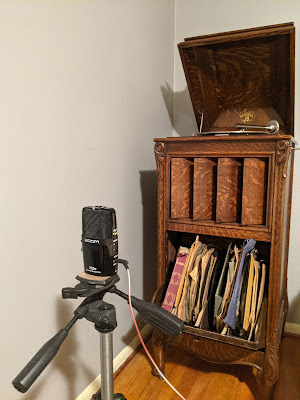Eventually it came to me, including a fair assortment of older style
(mechanically made) 78 RPM records. I had the idea that I would like to make
digital recording of my great-grandparents' record collection and I figured a
good way to do this was to mic up and record this Grafonola itself.
When I got this though, that was a not completely straight forward thing to
do. It would take a little figuring out. So the Grafonola sat around for
a few years.
Although it had worked relatively recently, when I did go to play it a few years ago, I
found the tone arm was close to too stiff to move easily across the record as
they played. I thought it must need some lubrication. But it was not
immediately obvious how to remove and disassemble the joints in it. This
project not being urgent, I figured I'd come back to it.
More years went by. Oddly, I thought, the problem seemed to get worse. It was a shame because everything else seemed to work.
Overall this unit, built as near as I can tell around 1915, is in
remarkable condition. There's barely a scratch on the oak cabinet, the motor
works fine, there's no corrosion, and even the green felt pad on the turntable
is good.
I figured it really should be possible to get this to work. Recently I
became determined to figure it out. So I started with Google and did some
reading.
A small amount of background... The player is fully mechanical. There is a
regulated spring powered motor inside. It winds up using a crank and turns the
turntable, not unlike a clock. Vibration of the stylus in the record's groove
is amplified from a mica diaphragm, through the hollow tonearm and a horn-like
sound box below. The volume is controlled by opening and closing the baffles
on the front.
There are three types of needles used on this player; soft, medium and loud.
And yes, that refers to how loud they play. The stylus must be replaced after
each play of 2 sides of a record. The used stylus is discarded, otherwise the
records will be damaged. New packs of the needles are available today, and are
very inexpensive.
These players play records made at 78 RPMs. But they are quite different in
other ways from modern LPs as well and not at all compatible. They are even a little different from more modern 78s. There are today
a couple makers of photo cartridge and stylus combinations designed to play
the old format. I never thought I'd be shopping turntables in 2021, but
setting this solution up became my plan B if I couldn't get the Grafonola to work.
It did not take much research to find out that my problem with the tonearm is
quite common. The tonearm is made of cast "pot metal". This material, over
decades, swells up. Eventually the joints will not move. The only way to fix
this is to get it apart, somehow, and sand or otherwise reduce the working
surfaces.
I was pleased to learn that, again, this example is in much better shape than
most. My up/down joint was fine. The left/right joint was only very stiff.
Most tonearms get completely frozen up solid.
Pot metal is very brittle. It is said to literally shatter under too much
force. I read about many people having these things crumble in their hands
while trying to pull them apart. So I didn't pull very hard... The trick that
worked was putting the whole thing in the freezer for a couple hours. After
that, the arm came out of its base with no trouble at all!
A fine sand paper was all that was needed to make the left/right motion work
again. I took the extra step though of mirror-polishing the reduced surface
because, why not?
A "dry" (non-paraffin based) lubricant is recommended for the pot metal tonearms.
Apparently common oils can make the problem worse. I used a lubricant made
for bike chains.
The tonearm worked perfectly. I ordered up some medium needles and the
Grafonola is ready to go!
I can't say enough good about this little thing. The quality is great. It's
the perfect tools for the job.
One thing to note about it though is that it is said to work without a memory card. This is true, but the functionality without memory is very limited. You'll need a card, 2 GB or less (a larger one I already had didn't work).
Now on with the project...





2 comments:
Fascinating description Jeff! Thanks for sharing the details. Good luck with the recordings...
Thanks!
Post a Comment